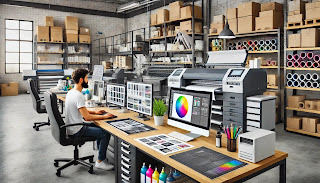- Get link
- X
- Other Apps
Starting a printing press is an extensive process that involves planning, investment, and execution. Below is a structured guide covering the key steps, along with an image to illustrate the process visually.
Step 1: Market Research and Business Planning
Before investing, conduct thorough research:
-
Identify demand in your area.
-
Determine the type of printing services (offset, digital, screen printing, flex, etc.).
-
Analyze competitors and pricing.
-
Define your target audience (businesses, individuals, publishers, etc.).
-
Create a business plan covering costs, revenue streams, and growth strategies.
Step 2: Legal and Business Registration
Register your printing business by following these steps:
-
Choose a business structure (sole proprietorship, partnership, or company).
-
Register with local authorities and get necessary licenses.
-
Apply for a GST number (if applicable).
-
Open a business bank account.
Step 3: Choosing the Right Location
Your printing press needs a spacious and well-ventilated place:
-
Ensure easy access for transportation.
-
Consider space for machines, storage, and customer interactions.
-
Industrial areas often provide lower rental costs.
Step 4: Purchasing Printing Equipment
Different types of printing require different machines:
-
Offset Printing: Best for large-scale printing (books, newspapers).
-
Digital Printing: Ideal for small businesses (flyers, brochures).
-
Screen Printing: Good for textiles, posters.
-
Flex Printing: Used for banners and signage.
Other essential tools:
-
Cutting and binding machines.
-
Designing computers with Adobe Photoshop, Illustrator, CorelDRAW.
-
High-quality ink and paper stock.
Step 5: Setting Up the Press
-
Install machines properly.
-
Ensure proper ventilation and safety measures.
-
Arrange working tables, computers, and material storage.
Step 6: Hiring Skilled Staff
A printing press requires:
-
Machine operators.
-
Graphic designers.
-
Sales and customer support staff.
-
Delivery personnel.
Training is crucial for quality work and efficiency.
Step 7: Marketing and Online Presence
-
Develop a professional website showcasing services.
-
Use social media marketing (Facebook, Instagram, LinkedIn).
-
List your business on Google My Business.
-
Offer competitive pricing and discounts for bulk orders.
Step 8: Managing Operations and Finances
-
Maintain stock of paper and ink.
-
Track orders and ensure timely delivery.
-
Use accounting software for billing and expenses.
Step 9: Scaling Your Business
-
Introduce new services like custom merchandise printing.
-
Collaborate with local businesses for bulk orders.
-
Expand to e-commerce for online printing orders.
Visual Representation
I'll generate an image illustrating a basic printing press setup.

Comments
Post a Comment